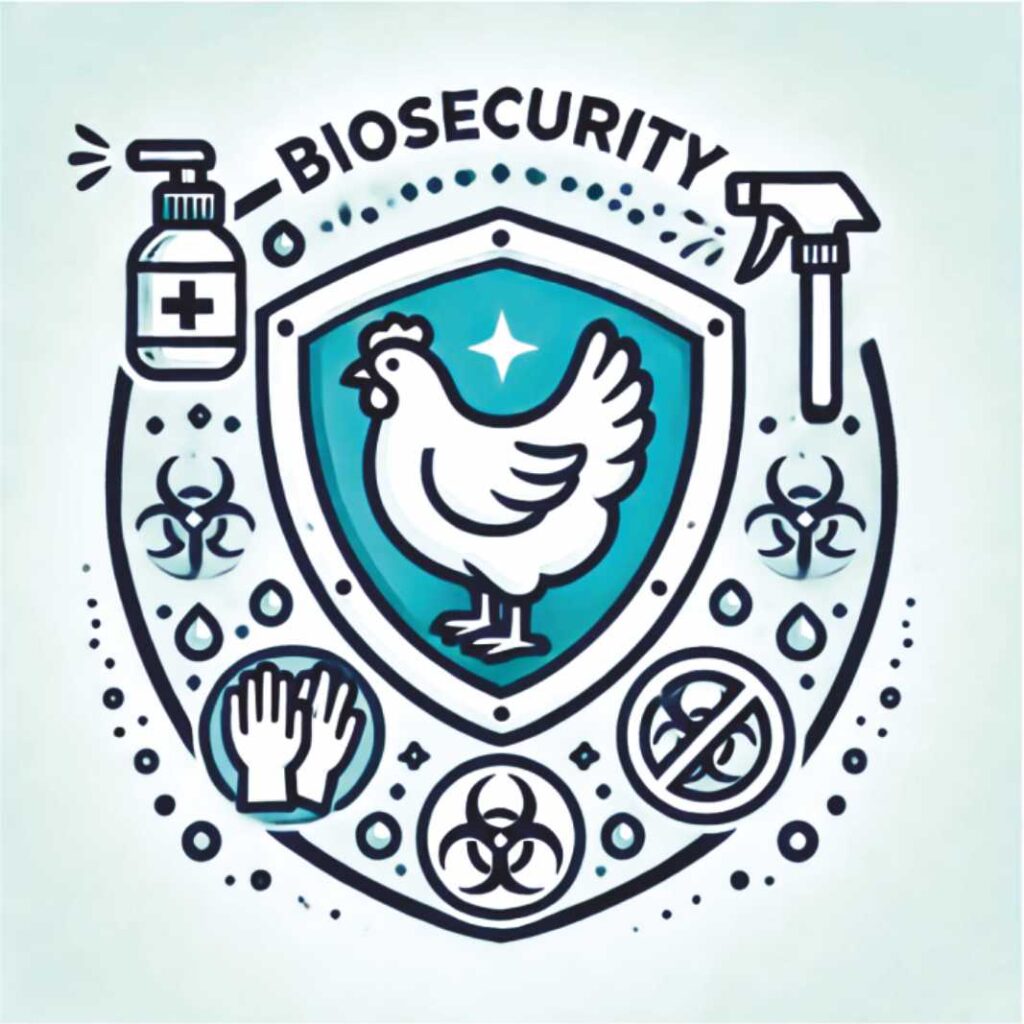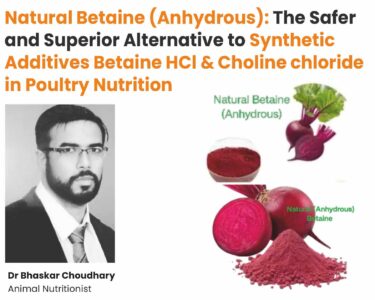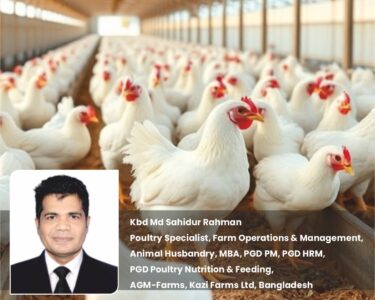Biosecurity Measures – The First Line of Defence Against Bird Flu
Dr. Sagrika Bhat1, Dr. Sundus Gazal2, Dr. Sabahat Gazal3and Dr. Anvesha Bhan4
1Division of Veterinary Biochemistry, 2,3,4Division of Veterinary Microbiology
and Immunology, Sher-e-Kashmir University of Agricultural Sciences and Technology of Jammu

Microscopic pathogens, including bacteria, viruses, fungi, and parasites, pose significant threats to poultry health, with avian influenza being a major concern due to its high mortality, economic impact, and zoonotic potential. The disease is caused by Influenza A virus belonging to the family Orthomyxoviridae. Influenza A viruses are divided into subtypes based on two proteins on the surface of the virus: hemagglutinin (H) and neuraminidase (N). There are 18 different hemagglutinin subtypes and 11 different neuraminidase subtypes (H1 through H18 and N1 through N11, respectively). The highly pathogenic strains such as H5N1, H7N9, and H9N2 have been reported to cause severe disease. The virus spreads through direct contact with infected birds, contaminated feed, water, and fomites, while wild migratory birds serve as natural reservoirs, enabling global transmission. Highly pathogenic avian influenza can lead to near-total flock mortality, significantly disrupting poultry production and trade. Additionally, zoonotic strains such as H5N1 and H7N9 can cause severe respiratory illness, pneumonia, multi-organ failure, and high fatality rates in humans, necessitating global surveillance by organizations like the World Health Organization (WHO).
Poultry farms constantly face the risk of Avian influenza and other infectious diseases that persist in dust, droppings, and farm waste, making biosecurity a fundamental component of disease prevention. Biosecurity measures serve as the first line of defence, preventing pathogen entry and transmission through stringent hygiene, controlled farm access, and optimized housing conditions. Effective biosecurity minimizes outbreaks of avian influenza, Newcastle disease, duck plague, and bacterial infections such as fowl cholera and mycoplasmosis, which compromise poultry health, reduce productivity, and weaken consumer confidence.
Given the increasing incidence of avian influenza worldwide, including India, strengthening biosecurity is imperative to safeguard poultry health and public safety. Disease prevention strategies must integrate high-quality stock, proper housing, clean feed and water, regular disinfection, and restricted farm access. Additionally, modifying industry practices in poultry production, transport, and marketing is essential to curb disease spread. Veterinary authorities must continuously evaluate and refine biosecurity measures in high-risk areas while considering economic and social impacts. Several biosecurity measures have been implemented or require further revision in Asian countries, including India, to effectively control avian influenza and ensure sustainable poultry production. Above all, biosecurity must be a continuous effort rather than a reactive response to outbreaks.
A well-structured, proactive approach remains critical for preventing disease outbreaks, ensuring industry stability, and minimizing zoonotic risks.
Key Biosecurity Measures in the Poultry Industry
1. Marketing Systems: Live bird markets serve as critical points for avian influenza (AI) transmission due to continuous operation, overnight poultry retention, and the reintroduction of unsold birds to farms. These practices facilitate pathogen circulation. Implementing a mandatory market rest period of 24 hours in a week, accompanied by thorough cleaning and disinfection, is essential to mitigate viral persistence and spread.
2. Species Segregation: Domestic waterfowl and quail act as reservoirs for avian influenza viruses. Their cohabitation, transportation, and marketing alongside other poultry should be restricted to minimize interspecies transmission. Additionally, swine reared in proximity to infected poultry farms are found to be infected with HPAI (Highly Pathogenic Avian Influenza) therefore should undergo systematic veterinary surveillance. In cases of confirmed avian influenza infection, culling of affected herds is recommended to prevent viral reassortment and potential zoonotic spillover.
3. Farming Practices: Extensive poultry rearing systems, particularly in village settings, pose a heightened risk for avian influenza introduction due to their lack of biosecurity controls. Strategic vaccination programs targeting backyard poultry can enhance herd immunity. Commercial farms should adhere to an ‘all-in, all-out’ production model to reduce pathogen exposure and poultry workers must adhere to strict biosecurity protocols, including cleaning, disinfecting, or changing protective clothing, equipment, and footwear before entering and after leaving farms.
4. Transport Biosecurity: Transport cages and egg containers should be constructed from non-porous materials such as plastic or metal over wooden cages to facilitate effective disinfection. To prevent environmental contamination and disease spread, bio-secure transport protocols should be implemented. This includes minimizing faecal contamination during poultry unloading, ensuring transport cages are cleaned and disinfected before returning to farms, and using easily sanitized materials for transporting table eggs, fertile eggs, and day-old chicks.
5. Compartmentalization: In regions where avian influenza is endemic, creating compartmentalized poultry populations with distinct health statuses is essential for disease control and international trade compliance. This requires strict biosecurity measures, including traceability of fertilized eggs, certified hatchery and feed sources, vermin control, and regulated transport. Poultry operators must maintain detailed records of suppliers, egg crate circulation, employee responsibilities, and transport activities to ensure compliance and effective disease containment.
Mitigation of Stress through Managemental Interventions
While biosecurity is crucial for disease prevention, stress reduction is equally important in enhancing poultry resistance to infections, including avian influenza. Environmental factors such as high temperatures, ammonia build-up, overcrowding, feed deprivation, handling, and transportation induce physiological stress, compromising immunity. Strategies such as adjusting feeding schedules, providing cool drinking water, supplementing essential nutrients, and optimizing dietary energy and amino acid levels help mitigate heat stress. Maintaining appropriate temperature, ventilation, and humidity is vital for flock health, especially in regions with high heat and humidity. Since wet litter contributes significantly to ammonia production, proper litter management, ventilation, and dietary adjustments are necessary to reduce ammonia levels and support biosecurity measures.
Nutritional Biosecurity Measures
Poultry immunity depends on proper nutrition, as essential nutrients regulate immune cell activity and function. Balanced diets rich in proteins, vitamins, trace minerals, and energy sources are critical for disease resistance. Probiotics enhance immunocompetence by stimulating antibody production, while prebiotics selectively promote beneficial gut bacteria, improving immune function. Additionally, mycotoxins in poultry feed suppress immune responses, making birds more susceptible to infections. Strict feed quality control and mycotoxin mitigation strategies should be integral to biosecurity programs.
Hygienic Disposal of Poultry Waste
Poultry operations generate waste, including dead birds, broken eggs, manure, litter, and contaminated equipment, which serve as reservoirs for pathogens. Proper disposal methods include burial, incineration, rendering, and composting.
Burial is effective but requires a 90-day period for pathogen deactivation before use as fertilizer. Incineration is reliable but often limited by facility size. Open burning is costly and environmentally unfavourable. Rendering is viable if decontamination is ensured, though private facilities may be reluctant to handle infected material. Composting within farm premises minimizes the risk of disease transmission during transport. Additionally, high-risk practices like using contaminated water and recycling untreated poultry waste should be strictly prohibited.

Wild Bird and Vector Control for Disease Prevention
Wild birds, particularly waterfowl, act as reservoirs for avian influenza and other pathogens, and play an important role in introducing infections to poultry farms. Effective biosecurity includes wild bird-proofing quarantine facilities and preventing their access to contaminated areas. Rodent control is equally essential, as rats and mice serve as mechanical carriers of the pathogens. A structured eradication program should minimize their dispersal from infected sites. Flying insects also contribute to disease transmission; thus, integrated pest management strategies should be implemented to reduce their presence in poultry sheds.
Immunomodulation through Nutritional Supplementation and Genetic Strategies
Regular supplementation of vitamins, minerals, and proteins strengthen poultry immunity and should be a core component of modern biosecurity. Nutrient deficiencies compromise resistance, increasing vulnerability to avian influenza and other diseases. As the influenza virus rapidly mutates and can exist as various subtypes and pathotypes, it questions the efficacy of existing vaccines and antivirals, and hence, genetic interventions offer a promising alternative. Screening poultry populations for disease-resistant genes, particularly in native breeds, and incorporating these traits through selective breeding can enhance flock resilience against infections.
Vaccination Strategies for Avian Influenza
Vaccination integrated with biosecurity measures can act as a critical tool for influenza control. Vaccines should provide adequate protection and minimize virus shedding. Vaccination programs coupled with virological and serological surveillance can be used to effectively detect viral mutations and assess vaccine effectiveness. In past influenza outbreaks in Maharashtra, Gujarat, and Madhya Pradesh, India successfully controlled the disease through culling and biosecurity measures. Establishing vaccine banks and enhancing domestic vaccine production are essential for rapid response to outbreaks. Policymakers must decide on vaccination strategies based on epidemiological data and national disease trends.
Strengthening Quarantine and Flock Profiling
Strict quarantine protocols are crucial in preventing disease introduction through newly acquired birds. Newly introduced poultry should be isolated for at least 21 days, monitored for clinical symptoms, and tested (blood, faecal, and nasal swabs) before integration with existing flocks. Beyond farm-level quarantine, strict regulations should be enforced to control cross-border movement of live poultry and poultry products.
Conclusion:
Effective biosecurity is the cornerstone of bird flu prevention and control, serving as the primary defence against disease outbreaks in poultry. Raising awareness among poultry farmers, industry stakeholders, and policymakers is essential for strengthening biosecurity at all levels. Training programs for grassroots poultry managers should be prioritized to ensure the proper implementation of preventive measures. In addition to immunity-boosting strategies and advancements in disease control, continuous surveillance of avian influenza and other infectious diseases is crucial. A proactive and well-enforced biosecurity framework not only safeguards poultry health and industry stability but also minimizes public health risks associated with zoonotic disease transmission. By integrating stringent biosecurity protocols with modern disease prevention strategies, the poultry sector can achieve long-term sustainability and resilience against emerging threats like avian influenza.






